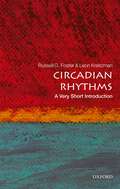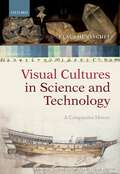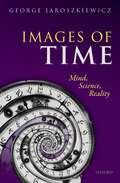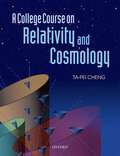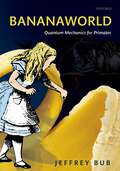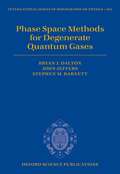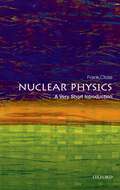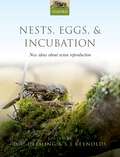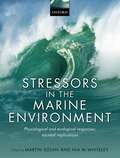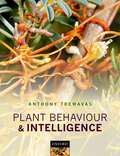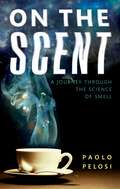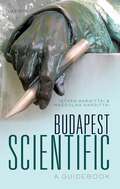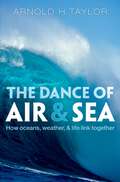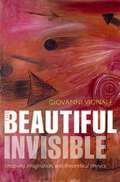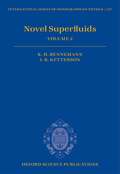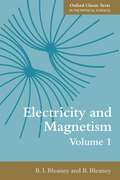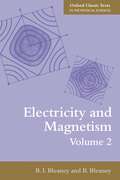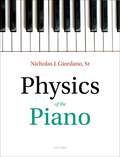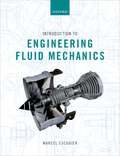- Table View
- List View
Circadian Rhythms: A Very Short Introduction (Very Short Introductions)
by Russell Foster Leon KreitzmanThe earth's daily rotation affects just about every living creature. From dawn through to dusk, there are changes in light, temperature, humidity, and rainfall. However, these changes are regular, rhythmic and, therefore, predictable. Thus, the near 24 hour circadian rhythm is innate: a genetically programmed clock that essentially ticks of its own accord. This Very Short Introduction explains how organisms can "know" the time and reveals what we now understand of the nature and operation of chronobiological processes. Covering variables such as light, the metabolism, human health, and the seasons, Foster and Kreitzman illustrate how jet lag and shift work can impact on human well-being, and consider circadian rhythms alongside a wide range of disorders, from schizophrenia to obesity. ABOUT THE SERIES: The Very Short Introductions series from Oxford University Press contains hundreds of titles in almost every subject area. These pocket-sized books are the perfect way to get ahead in a new subject quickly. Our expert authors combine facts, analysis, perspective, new ideas, and enthusiasm to make interesting and challenging topics highly readable.
Circadian Rhythms: A Very Short Introduction (Very Short Introductions)
by Leon Kreitzman Russell FosterThe earth's daily rotation affects just about every living creature. From dawn through to dusk, there are changes in light, temperature, humidity, and rainfall. However, these changes are regular, rhythmic and, therefore, predictable. Thus, the near 24 hour circadian rhythm is innate: a genetically programmed clock that essentially ticks of its own accord. This Very Short Introduction explains how organisms can "know" the time and reveals what we now understand of the nature and operation of chronobiological processes. Covering variables such as light, the metabolism, human health, and the seasons, Foster and Kreitzman illustrate how jet lag and shift work can impact on human well-being, and consider circadian rhythms alongside a wide range of disorders, from schizophrenia to obesity. ABOUT THE SERIES: The Very Short Introductions series from Oxford University Press contains hundreds of titles in almost every subject area. These pocket-sized books are the perfect way to get ahead in a new subject quickly. Our expert authors combine facts, analysis, perspective, new ideas, and enthusiasm to make interesting and challenging topics highly readable.
Visual Cultures in Science and Technology: A Comparative History
by Klaus HentschelThis book is offers a broad, comparative survey of a booming field within the history of science: the history, generation, use, and function of images in scientific practice. It explores every aspect of visuality in science, arguing for the concept of visual domains. What makes a good scientific image? What cultural baggage is essential to it? Is science indeed defined by its pictures? This book aims to provide a synthesis of the history, generation, use, and transfer of images in scientific practice. It delves into the rich reservoir of case studies on visual representations in scientific and technological practice that have accumulated over the past couple of decades by historians, sociologists, and philosophers of science. The main aim is thus located on the meta-level. It adopts an integrative view of recurrently noted general features of visual cultures in science and technology, something hitherto unachieved and believed by many to be a mission impossible. By systematic comparison of numerous case studies, the purview broadens away from myopic microanalysis in search of overriding patterns. The many different disciplines and research areas involved encompass mathematics, technology, natural history, medicine, the geosciences, astronomy, chemistry, and physics. The chosen examples span the period from the Renaissance to the late 20th century. The broad range of visual representations in scientific practice is treated, as well as schooling in pattern recognition, design and implementation of visual devices, and a narrowing in on the special role of illustrators and image specialists.
Images of Time: Mind, Science, Reality
by George JaroszkiewiczHave you ever wondered about Time: what it is or how to discuss it? If you have, then you may have been bewildered by the many different views and opinions in many diverse fields to be found, such as physics, mathematics, philosophy, religion, history, and science fiction novels and films. This book will help you unravel fact from fiction. It provides a broad survey of many of these views, these images of time, covering historical, cultural, philosophical, biological, mathematical and physical images of time, including classical and quantum mechanics, special and general relativity and cosmology. This book gives you more than just a review of such images. It provides the reader a basis for judging the scientific soundness of these various images. It develops the reader's critical ability to distinguish Images of Time in terms of its contextual completeness. Differentiating between metaphysical images (which cannot be scientifically validated) and those that could, in principle, be put to empirical test. Showing that mathematical and classical mechanical images are more complete, and genuine quantum mechanics based images have the greatest degree of contextual completeness. Through the use of a simple algorithm, the reader can decide the classification of any of the images of time discussed in this book. These distinctions are of particular importance in this day and age, when we are flooded by a plethora of competing Images of Time. Many of these have no scientific basis or empirical support or content. This book will be of value not only to philosophers, scientists and students, but also to the general reader interested in this fundamental topic, because it introduces a method of distinguishing between science fiction and science fact.
A College Course on Relativity and Cosmology
by Ta-Pei ChengThis advanced undergraduate text introduces Einstein's general theory of relativity. The topics covered include geometric formulation of special relativity, the principle of equivalence, Einstein's field equation and its spherical-symmetric solution, as well as cosmology. An emphasis is placed on physical examples and simple applications without the full tensor apparatus. It begins by examining the physics of the equivalence principle and looks at how it inspired Einstein's idea of curved spacetime as the gravitational field. At a more mathematically accessible level, it provides a metric description of a warped space, allowing the reader to study many interesting phenomena such as gravitational time dilation, GPS operation, light deflection, precession of Mercury's perihelion, and black holes. Numerous modern topics in cosmology are discussed from primordial inflation and cosmic microwave background to the dark energy that propels an accelerating universe. Building on Cheng's previous book, 'Relativity, Gravitation and Cosmology: A Basic Introduction', this text has been tailored to the advanced student. It concentrates on the core elements of the subject making it suitable for a one-semester course at the undergraduate level. It can also serve as an accessible introduction of general relativity and cosmology for those readers who want to study the subject on their own. The proper tensor formulation of Einstein's field equation is presented in an appendix chapter for those wishing to glimpse further at the mathematical details.
Bananaworld: Quantum Mechanics for Primates
by Jeffrey BubWhat on earth do bananas have to do with quantum mechanics? From a modern perspective, quantum mechanics is about strangely counterintuitive correlations between separated systems, which can be exploited in feats like quantum teleportation, unbreakable cryptographic schemes, and computers with enormously enhanced computing power. Schrodinger coined the term "entanglement" to describe these bizarre correlations. Bananaworld — an imaginary island with "entangled" bananas — brings to life the fascinating discoveries of the new field of quantum information without the mathematical machinery of quantum mechanics. The connection with quantum correlations is fully explained in sections written for the non-physicist reader with a serious interest in understanding the mysteries of the quantum world. The result is a subversive but entertaining book that is accessible and interesting to a wide range of readers, with the novel thesis that quantum mechanics is about the structure of information. What we have discovered is that the possibilities for representing, manipulating, and communicating information are very different than we thought.
Phase Space Methods for Degenerate Quantum Gases (International Series of Monographs on Physics #163)
by Bryan J. Dalton John Jeffers Stephen M. BarnettRecent experimental progress has enabled cold atomic gases to be studied at nano-kelvin temperatures, creating new states of matter where quantum degeneracy occurs - Bose-Einstein condensates and degenerate Fermi gases. Such quantum states are of macroscopic dimensions. This book presents the phase space theory approach for treating the physics of degenerate quantum gases, an approach already widely used in quantum optics. However, degenerate quantum gases involve massive bosonic and fermionic atoms, not massless photons. The book begins with a review of Fock states for systems of identical atoms, where large numbers of atoms occupy the various single particle states or modes. First, separate modes are considered, and here the quantum density operator is represented by a phase space distribution function of phase space variables which replace mode annihilation, creation operators, the dynamical equation for the density operator determines a Fokker-Planck equation for the distribution function, and measurable quantities such as quantum correlation functions are given as phase space integrals. Finally, the phase space variables are replaced by time dependent stochastic variables satisfying Langevin stochastic equations obtained from the Fokker-Planck equation, with stochastic averages giving the measurable quantities. Second, a quantum field approach is treated, the density operator being represented by a distribution functional of field functions which replace field annihilation, creation operators, the distribution functional satisfying a functional FPE, etc. A novel feature of this book is that the phase space variables for fermions are Grassmann variables, not c-numbers. However, we show that Grassmann distribution functions and functionals still provide equations for obtaining both analytic and numerical solutions. The book includes the necessary mathematics for Grassmann calculus and functional calculus, and detailed derivations of key results are provided.
Nuclear Physics: A Very Short Introduction (Very Short Introductions)
by Frank CloseNuclear physics began long before the identification of fundamental particles, with J. J. Thomson's discovery of the electron at the end of the 19th century, which implied the existence of a positive charge in the atom to make it neutral. In this Very Short Introduction Frank Close gives an account of how this area of physics has progressed, including the recognition of how heavy nuclei are built up in the cores of stars and in supernovae, the identification of quarks and gluons, and the development of quantum chromodynamics (QCD). Exploring key concepts such as the stability of different configurations of protons and neutrons in nuclei, Frank Close shows how nuclear physics brings the physics of the stars to Earth and provides us with important applications, particularly in medicine. ABOUT THE SERIES: The Very Short Introductions series from Oxford University Press contains hundreds of titles in almost every subject area. These pocket-sized books are the perfect way to get ahead in a new subject quickly. Our expert authors combine facts, analysis, perspective, new ideas, and enthusiasm to make interesting and challenging topics highly readable.
Nuclear Physics: A Very Short Introduction (Very Short Introductions)
by Frank CloseNuclear physics began long before the identification of fundamental particles, with J. J. Thomson's discovery of the electron at the end of the 19th century, which implied the existence of a positive charge in the atom to make it neutral. In this Very Short Introduction Frank Close gives an account of how this area of physics has progressed, including the recognition of how heavy nuclei are built up in the cores of stars and in supernovae, the identification of quarks and gluons, and the development of quantum chromodynamics (QCD). Exploring key concepts such as the stability of different configurations of protons and neutrons in nuclei, Frank Close shows how nuclear physics brings the physics of the stars to Earth and provides us with important applications, particularly in medicine. ABOUT THE SERIES: The Very Short Introductions series from Oxford University Press contains hundreds of titles in almost every subject area. These pocket-sized books are the perfect way to get ahead in a new subject quickly. Our expert authors combine facts, analysis, perspective, new ideas, and enthusiasm to make interesting and challenging topics highly readable.
Nests, Eggs, and Incubation: New ideas about avian reproduction
Nests, Eggs, and Incubation brings together a global team of leading authorities to provide a comprehensive overview of the fascinating and diverse field of avian reproduction. Starting with a new assessment of the evolution of avian reproductive biology in light of recent research, the book goes on to cover four broad areas: the nest, the egg, incubation, and the study of avian reproduction. New research on nest structures, egg traits, and life history is incorporated, whilst contemporary methodologies such as self-contained temperature probes and citizen science are also discussed. Applied chapters describe how biological knowledge can be applied to challenges such as urbanisation and climate change. The book concludes by suggesting priorities for future research. This book builds upon the foundations laid down by Charles Deeming's 2002 work Avian Incubation (available for readers of this book to access online for free), much of which remains relevant today. Read in conjunction with this previous volume, it provides an up-to-date and thorough review of egg biology, nest function, and incubation behaviour, which will be an essential resource for students of avian biology, as well as both professional and amateur ornithologists working in the field of avian reproduction.
Nests, Eggs, and Incubation: New ideas about avian reproduction
by D. C. Deeming and S. J. ReynoldsNests, Eggs, and Incubation brings together a global team of leading authorities to provide a comprehensive overview of the fascinating and diverse field of avian reproduction. Starting with a new assessment of the evolution of avian reproductive biology in light of recent research, the book goes on to cover four broad areas: the nest, the egg, incubation, and the study of avian reproduction. New research on nest structures, egg traits, and life history is incorporated, whilst contemporary methodologies such as self-contained temperature probes and citizen science are also discussed. Applied chapters describe how biological knowledge can be applied to challenges such as urbanisation and climate change. The book concludes by suggesting priorities for future research. This book builds upon the foundations laid down by Charles Deeming's 2002 work Avian Incubation (available for readers of this book to access online for free), much of which remains relevant today. Read in conjunction with this previous volume, it provides an up-to-date and thorough review of egg biology, nest function, and incubation behaviour, which will be an essential resource for students of avian biology, as well as both professional and amateur ornithologists working in the field of avian reproduction.
Stressors in the Marine Environment: Physiological and ecological responses; societal implications
A multitude of direct and indirect human influences have significantly altered the environmental conditions, composition, and diversity of marine communities. However, understanding and predicting the combined impacts of single and multiple stressors is particularly challenging because observed ecological feedbacks are underpinned by a number of physiological and behavioural responses that reflect stressor type, severity, and timing. Furthermore, integration between the traditional domains of physiology and ecology tends to be fragmented and focused towards the effects of a specific stressor or set of circumstances. This novel volume summarises the latest research in the physiological and ecological responses of marine species to a comprehensive range of marine stressors, including chemical and noise pollution, ocean acidification, hypoxia, UV radiation, thermal and salinity stress before providing a perspective on future outcomes for some of the most pressing environmental issues facing society today. Stressors in the Marine Environment synthesises the combined expertise of a range of international researchers, providing a truly interdisciplinary and accessible summary of the field. It is essential reading for graduate students as well as professional researchers in environmental physiology, ecology, marine biology, conservation biology, and marine resource management. It will also be of particular relevance and use to the regulatory agencies and authorities tasked with managing the marine environment, including social scientists and environmental economists.
Stressors in the Marine Environment: Physiological and ecological responses; societal implications
by Martin Solan and Nia M. WhiteleyA multitude of direct and indirect human influences have significantly altered the environmental conditions, composition, and diversity of marine communities. However, understanding and predicting the combined impacts of single and multiple stressors is particularly challenging because observed ecological feedbacks are underpinned by a number of physiological and behavioural responses that reflect stressor type, severity, and timing. Furthermore, integration between the traditional domains of physiology and ecology tends to be fragmented and focused towards the effects of a specific stressor or set of circumstances. This novel volume summarises the latest research in the physiological and ecological responses of marine species to a comprehensive range of marine stressors, including chemical and noise pollution, ocean acidification, hypoxia, UV radiation, thermal and salinity stress before providing a perspective on future outcomes for some of the most pressing environmental issues facing society today. Stressors in the Marine Environment synthesises the combined expertise of a range of international researchers, providing a truly interdisciplinary and accessible summary of the field. It is essential reading for graduate students as well as professional researchers in environmental physiology, ecology, marine biology, conservation biology, and marine resource management. It will also be of particular relevance and use to the regulatory agencies and authorities tasked with managing the marine environment, including social scientists and environmental economists.
Plant Behaviour and Intelligence
by Anthony TrewavasThis book provides a convincing argument for the view that whole cells and whole plants growing in competitive wild conditions show aspects of plant behaviour that can be accurately described as 'intelligent'. Trewavas argues that behaviour, like intelligence, must be assessed within the constraints of the anatomical and physiological framework of the organism in question. The fact that plants do not have centralized nervous systems for example, does not exclude intelligent behaviour. Outside the human dimension, culture is thought largely absent and fitness is the biological property of value. Thus, solving environmental problems that threaten to reduce fitness is another way of viewing intelligent behaviour and has a similar meaning to adaptively variable behaviour. The capacity to solve these problems might be considered to vary in different organisms, but variation does not mean absence. By extending these ideas into a book that allows a critical and amplified discussion, the author hopes to raise an awareness of the concept of purposive behaviour in plants.
Plant Behaviour and Intelligence
by Anthony TrewavasThis book provides a convincing argument for the view that whole cells and whole plants growing in competitive wild conditions show aspects of plant behaviour that can be accurately described as 'intelligent'. Trewavas argues that behaviour, like intelligence, must be assessed within the constraints of the anatomical and physiological framework of the organism in question. The fact that plants do not have centralized nervous systems for example, does not exclude intelligent behaviour. Outside the human dimension, culture is thought largely absent and fitness is the biological property of value. Thus, solving environmental problems that threaten to reduce fitness is another way of viewing intelligent behaviour and has a similar meaning to adaptively variable behaviour. The capacity to solve these problems might be considered to vary in different organisms, but variation does not mean absence. By extending these ideas into a book that allows a critical and amplified discussion, the author hopes to raise an awareness of the concept of purposive behaviour in plants.
On the Scent: A journey through the science of smell
by Paolo PelosiIn humans, the perception of odours adds a fourth dimension to life, from the scent of flowers, the aroma of foods, and all the subtle smells in the environment. But how many types of odours can we distinguish? Why do we like the food we like? Which are the most powerful odorants, and how well does the human sense of smell perform compared with that of a dog or a butterfly? The sense of smell is highly complex, and such complexity discouraged scientists for a long time, leaving the world of smell in an atmosphere of mystery. Only recently, thanks to the new tools furnished by molecular biology and neuroscience, are we beginning to answer these questions, uncovering the hidden secrets of our sense of smell, and decoding the language used by most animals to communicate. In this book, Paolo Pelosi, one of the leading figures in the development of the science of olfaction, recounts how the chemical alphabet behind smell has been pieced together over the past three decades. Drawing on anecdotes from his own scientific career, and celebrating the rich variety of smells from herbs to flowers to roast coffee and freshly baked bread, he weaves together an engaging and remarkable account of the science behind the most elusive of our senses.
On the Scent: A journey through the science of smell
by Paolo PelosiIn humans, the perception of odours adds a fourth dimension to life, from the scent of flowers, the aroma of foods, and all the subtle smells in the environment. But how many types of odours can we distinguish? Why do we like the food we like? Which are the most powerful odorants, and how well does the human sense of smell perform compared with that of a dog or a butterfly? The sense of smell is highly complex, and such complexity discouraged scientists for a long time, leaving the world of smell in an atmosphere of mystery. Only recently, thanks to the new tools furnished by molecular biology and neuroscience, are we beginning to answer these questions, uncovering the hidden secrets of our sense of smell, and decoding the language used by most animals to communicate. In this book, Paolo Pelosi, one of the leading figures in the development of the science of olfaction, recounts how the chemical alphabet behind smell has been pieced together over the past three decades. Drawing on anecdotes from his own scientific career, and celebrating the rich variety of smells from herbs to flowers to roast coffee and freshly baked bread, he weaves together an engaging and remarkable account of the science behind the most elusive of our senses.
Budapest Scientific: A Guidebook
by István Hargittai Magdolna HargittaiThis guidebook introduces the reader to the visible memorabilia of science and scientists in Budapest - statues, busts, plaques, buildings, and other artefacts. According to the Hungarian-American Nobel laureate Albert Szent-Györgyi, this metropolis at the crossroads of Europe has a special atmosphere of respect for science. It has been the venue of numerous scientific achievements and the cradle, literally, of many individuals who in Hungary, and even more beyond its borders, became world-renowned contributors to science and culture. Six of the eight chapters of the book cover the Hungarian Nobel laureates, the Hungarian Academy of Sciences, the university, the medical school, agricultural sciences, and technology and engineering. One chapter is about selected secondary schools from which seven Nobel laureates (Szent-Györgyi, de Hevesy, Wigner, Gabor, Harsanyi, Olah, and Kertész) and the five "Martians of Science" (von Kármán, Szilard, Wigner, von Neumann, and Teller) had graduated. The concluding chapter is devoted to scientist martyrs of the Holocaust. A special feature in surveying Hungarian science is the contributions of scientists that left their homeland before their careers blossomed and made their seminal discoveries elsewhere, especially in Great Britain and the United States. The book covers the memorabilia referring to both émigré scientists and those that remained in Hungary. The discussion is informative and entertaining. The coverage is based on the visible memorabilia, which are not necessarily proportional with achievements. Therefore, there is a caveat that one could not compile a history of science relying solely on the presence of the memorabilia.
The Dance of Air and Sea: How oceans, weather, and life link together
by Arnold H. TaylorHow can the tiny plankton in the sea just off Western Europe be affected by changes 6000 km away on the other side of the North Atlantic Ocean? How can a slight rise in the temperature of the surface of the Pacific Ocean have a devastating impact on amphibian life in Costa Rica? Living populations across the globe are connected by great swayings of the world's atmosphere and oceans, the largest of which is El Nino. For almost half a century, the numbers of some of the smallest animals in the North Sea have gone up and down as the Gulf Stream has moved north and south 4000 miles away at the coast of the USA. This connection has happened because the weather patterns over the North Atlantic are intertwined by a phenomenon first described by a Danish missionary in the eighteenth century, the North Atlantic Oscillation. In The Dance of Air and Sea Arnold Taylor focuses on the large-scale dynamics of the world's climate, looking at how the atmosphere and oceans interact, and the ways in which ecosystems in water and on land respond to changes in weather. He tells stories of how discoveries were made, and the scientists who made them; and he considers the crucial issues of how the discoveries aid our response to global warming.
The Beautiful Invisible: Creativity, imagination, and theoretical physics
by Giovanni VignaleThe realm of theoretical physics is teeming with abstract and beautiful concepts. And the task of imagining them is one that demands profound creativity, argues Giovanni Vignale. Explaining them is curiously akin to the craft of poets, or magical realist novelists such as Borges, and Musil, or Bulgakov's The Master and Margarita. In this unusual and sometimes poetic book, Vignale presents his own unorthodox accounts of fundamental theoretical concepts such as Newtonian mechanics, superconductivity, and Einstein's theory of relativity, showing that what may seem at first quite simple in fact turns out to be much more profound. As we delve behind now-familiar metaphors such as 'electron spin' and 'black hole', the world that we take for granted melts away, leaving a glimpse of something much stranger.
Novel Superfluids: Volume 2 (International Series of Monographs on Physics #157)
by Karl-Heinz Bennemann John B. KettersonVolume 2 of Novel Superfluids continues the presentation of recent results on superfluids, including novel metallic systems, superfluid liquids, and atomic/molecular gases of bosons and fermions, particularly when trapped in optical lattices. Since the discovery of superconductivity (Leyden, 1911), superfluid 4He (Moscow and Cambridge, 1937), superfluid 3He (Cornell, 1972), and observation of Bose-Einstein Condensation (BEC) of a gas (Colorado and MIT, 1995), the phenomenon of superfluidity has remained one of the most important topics in physics. Again and again, novel superfluids yield surprising and interesting behaviors. The many classes of metallic superconductors, including the high temperature perovskite-based oxides, MgB2, organic systems, and Fe-based pnictides, continue to offer challenges. The technical applications grow steadily. What the temperature and field limits are remains illusive. Atomic nuclei, neutron stars and the Universe itself all involve various aspects of superfluidity, and the lessons learned have had a broad impact on physics as a whole.
Electricity and Magnetism, Volume 1 (Oxford Classic Texts in the Physical Sciences)
by B. I. Bleaney B. BleaneyThis book is a reissue of the third and last edition of a classic text providing the reader with a comprehensive account at first degree or introductory graduate level of the principles and experimental aspects of electricity and magnetism, together with an elementary account of the underlying atomic theory. The book is available in a two-volume format. This first volume contains what is needed for a first course in electromagnetism, including electrostatics, electric circuits, magnetism, electromagnetic induction, and electromagnetic waves. SI units are used throughout and there are problems at the end of each chapter.
Electricity and Magnetism, Volume 2 (Oxford Classic Texts in the Physical Sciences)
by BI Bleaney B BleaneyThis book is a reissue of the third and last edition of a classic text providing the reader with a comprehensive account at first degree or introductory graduate level of the principles and experimental aspects of electricity and magnetism, together with an elementary account of the underlying atomic theory. The book is available in a two-volume format. This second volume includes coverage of electrical and magnetic properties of matter, dielectrics, conduction in metals, magnetic materials, semiconductors and their applications in electronics, superconductors, electronic devices and circuits, magnetic resonance. SI units are used throughout and there are problems at the end of each chapter.
Physics of the Piano
by Nicholas J. GiordanoWhy does a piano sound like a piano? A similar question can be asked of virtually all musical instruments. A particular note-such as middle C-can be produced by a piano, a violin, a clarinet, and many other instruments, yet it is easy for even a musically untrained listener to distinguish between these different instruments. A central quest in the study of musical instruments is to understand why the sound of the "same" note depends greatly on the instrument, and to elucidate which aspects of an instrument are most critical in producing the musical tones characteristic of the instrument. The primary goal of this book is to investigate these questions for the piano. The explanations in this book use a minimum of mathematics, and are intended for anyone who is interested in music and musical instruments. At the same time, there are many insights relating physics and the piano that will likely be interesting and perhaps surprising for many physicists.
Introduction to Engineering Fluid Mechanics
by Marcel EscudierWe inhabit a world of fluids, including air (a gas), water (a liquid), steam (vapour) and the numerous natural and synthetic fluids which are essential to modern-day life. Fluid mechanics concerns the way fluids flow in response to imposed stresses. The subject plays a central role in the education of students of mechanical engineering, as well as chemical engineers, aeronautical and aerospace engineers, and civil engineers. This textbook includes numerous examples of practical applications of the theoretical ideas presented, such as calculating the thrust of a jet engine, the shock- and expansion-wave patterns for supersonic flow over a diamond-shaped aerofoil, the forces created by liquid flow through a pipe bend and/or junction, and the power output of a gas turbine. The first ten chapters of the book are suitable for first-year undergraduates. The latter half covers material suitable for fluid-mechanics courses for upper-level students Although knowledge of calculus is essential, this text focuses on the underlying physics. The book emphasizes the role of dimensions and dimensional analysis, and includes more material on the flow of non-Newtonian liquids than is usual in a general book on fluid mechanics — a reminder that the majority of synthetic liquids are non-Newtonian in character.
